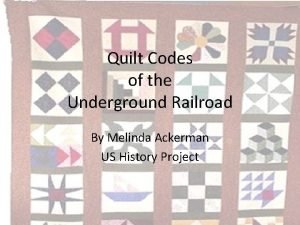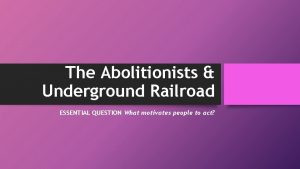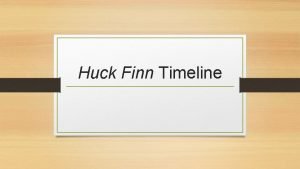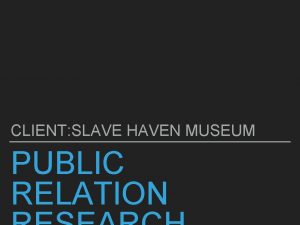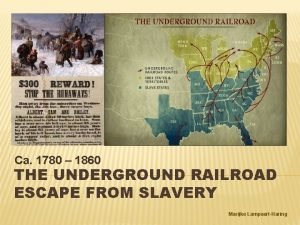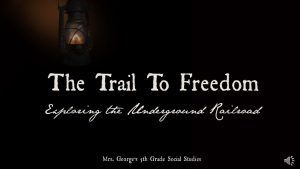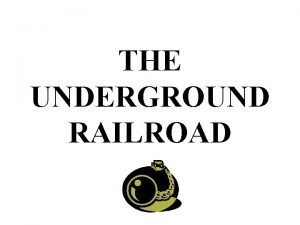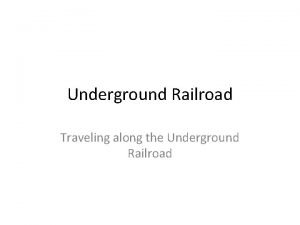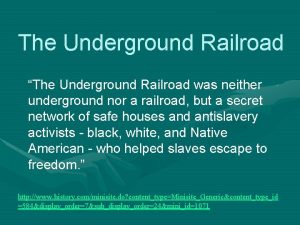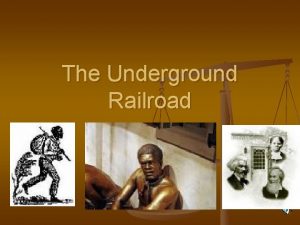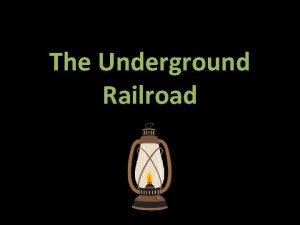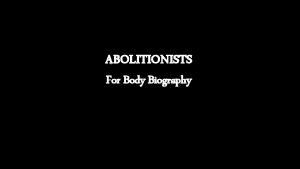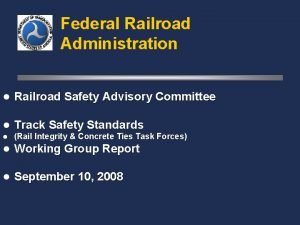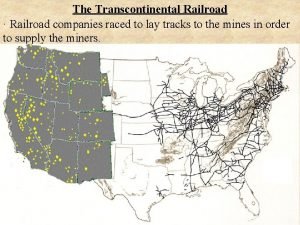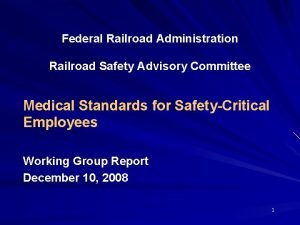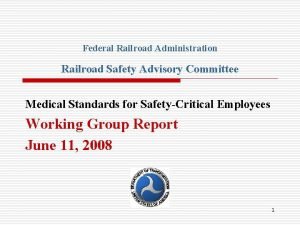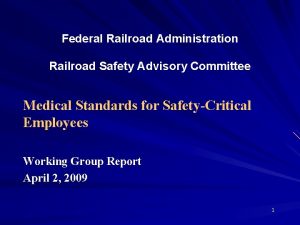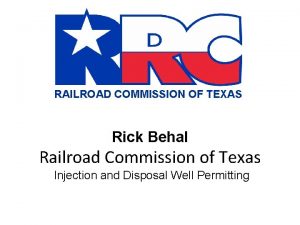The Underground Railroad Underground Railroad n n Is




























- Slides: 28

The Underground Railroad

Underground Railroad n n Is the first great freedom movement in the Americas and the first time people of different races and faiths worked together for freedom and justice. It was a secretive and effective organization. Peak time for the movement was between 1820 and 1865. Some people actually believe it was an actual train running underground from south to north

The Underground Railroad n n n The Underground Railroad was actually an above -ground series of escape routes for slaves traveling from the South to the North trying to gain their freedom. Slaves traveled by foot, wagons, boats, and trains. Slave runaways would usually travel by the light of night and hide during the day in places known as stations. These were safe houses owned by abolitionists.

Abolitionist n n Abolition-The movement to end slavery Abolitionist – a person who worked to end slavery. People against slavery

Terminology n n Secrecy was very important, therefore they used railroad terms to maintain secrecy and confuse others Tracks-fixed routes by abolitionists. n Stations or depotshiding places. n Terminal, heaven, Promised Land. Canada or free states. Station masters- those who hid slaves in their homes. Passengers, cargo, freight- escaped slaves The Drinking Gourd- Big Dipper constellation n


Henry Box Brown

Would you take the risk? ? ? n If the slaves were caught, they were sold or beaten with a whip; sometimes they were lynched.

Conductors were the people who led the runaways to freedom n n Could not carry a lot of supplies, slaves depended on conductors for meals, clothes, shelter and a bath when hiding in a shelter. When in the woods or wilderness, that had to hunt, forage and use creative ways to find food.

FAMOUS CONDUCTORS

Harriett Tubman

n n n Harriet Tubman was born a slave in Maryland. When she learned that her owner was going to sell her, she decided to escape. Tubman made 13 journeys from the South to the North as a Conductor on the Underground Railroad.


Harriet Tubman n n Southern Plantation owners offered $40, 000 for the capture of Harriet Tubman. Plantation Owners also offered rewards for the return of runaway slaves.

Sojourner Truth was born a slave in New York, and she fled to live with Quakers. n Truth spoke for abolition and women’s rights. n

William Lloyd Garrison n n Abolitionist Published an antislavery newspaper The Liberator that reached thousands worldwide.

Fredrick Douglass n Abolitionist Speaker n Published an autobiography n Former slave

Fugitive Slave Act of 1850 n n Dealt a severe blow to the movement. It meant slave owners could pursue and arrest fugitives anywhere in the U. S. Slave hunters did not discriminate between free blacks and runaways, took both back to the south. n n n Land water travel became more efficient All types of boats were used Expanding railroad was sympathetic to the movementallowed to travel as passengers or hide in freight cars, baggage cars or with livestock.

Routes to Freedom

THE UNDERGROUND RAILROAD

4 main routes n n 1. North along the Mississippi & Ohio Rivers to the north and Canada. 2. South to Florida and refuge with Seminole Tribe and Bahamas. 3. West along the Gulf of Mexico and into Mexico. 4. East along the seaboard into Canada.

Activity n n Watch clip on William Still http: //video. pbs. org/video/2181724307/ Use map and plot out your escape route as a group. Draw an arrow connecting plotted points, then compare paths. Assign different starting points for each group.

Routes n n n 1. Montgomery, AL-Philadelphia, PAToronto, Ontario, Canada. 2. Richmond, VA-Philadelphia, PAMontreal, Quebec, Canada. 3. Savannah, GA- Philadelphia, PASt. Catherines, Ontario, Canada. 4. Jackson, Mississippi- Detroit, Michigan. Windsor, Ontario, Canada. Vicksburg, MS – Philadelphia, PA- Canada

Routes n n n Which path is the shortest route? How many miles is each route? What rivers did you have to cross? What other cities did you stop in? How long do you think it would take?

Codes n n Word of mouth, codes in newspapers and letters, bulletins, storytelling and songs helped the travelers cross the 49 th parallel. They learned that the Detroit River was not 5, 000 miles wide and that crows in Canada did not peck out their eyes.

Spiritual song lyrics informed the travelers on the Underground Railroad

Spirituals n n Spirituals like “Wade in the Water”, “The Gospel Train” and “Swing Low, Sweet Chariot” directly refer to the Underground Railroad. Spirituals gradually evolved to serve a variety of purposes in the fight for freedom: 1) Singing as an expression of values 2) Singing as a source of inspiration or motivation 3) Singing as an expression of protest 4) Singing as a communication tool (codes)

Swing Low Sweet Chariot n n n Play the song and have students fill out worksheet. https: //www. youtube. com/watch? v=pw 6 N _e. TZP 2 U http: //www. youtube. com/watch? v=W 4 et. F QIOUp. I
 Shoofly quilt meaning
Shoofly quilt meaning Underground railroad
Underground railroad Huck's menu
Huck's menu Slave haven underground railroad museum cost
Slave haven underground railroad museum cost Underground railroad
Underground railroad Underground railroad painting
Underground railroad painting Underground railroad symbols
Underground railroad symbols Underground railroad definition apush
Underground railroad definition apush Thế nào là mạng điện lắp đặt kiểu nổi
Thế nào là mạng điện lắp đặt kiểu nổi Hát kết hợp bộ gõ cơ thể
Hát kết hợp bộ gõ cơ thể Các loại đột biến cấu trúc nhiễm sắc thể
Các loại đột biến cấu trúc nhiễm sắc thể Vẽ hình chiếu đứng bằng cạnh của vật thể
Vẽ hình chiếu đứng bằng cạnh của vật thể Thế nào là sự mỏi cơ
Thế nào là sự mỏi cơ Phản ứng thế ankan
Phản ứng thế ankan Gấu đi như thế nào
Gấu đi như thế nào Các môn thể thao bắt đầu bằng tiếng bóng
Các môn thể thao bắt đầu bằng tiếng bóng Sự nuôi và dạy con của hươu
Sự nuôi và dạy con của hươu Thiếu nhi thế giới liên hoan
Thiếu nhi thế giới liên hoan điện thế nghỉ
điện thế nghỉ Một số thể thơ truyền thống
Một số thể thơ truyền thống Trời xanh đây là của chúng ta thể thơ
Trời xanh đây là của chúng ta thể thơ Frameset trong html5
Frameset trong html5 Các số nguyên tố
Các số nguyên tố Tia chieu sa te
Tia chieu sa te Các châu lục và đại dương trên thế giới
Các châu lục và đại dương trên thế giới Thế nào là hệ số cao nhất
Thế nào là hệ số cao nhất Thang điểm glasgow
Thang điểm glasgow Sơ đồ cơ thể người
Sơ đồ cơ thể người ưu thế lai là gì
ưu thế lai là gì
